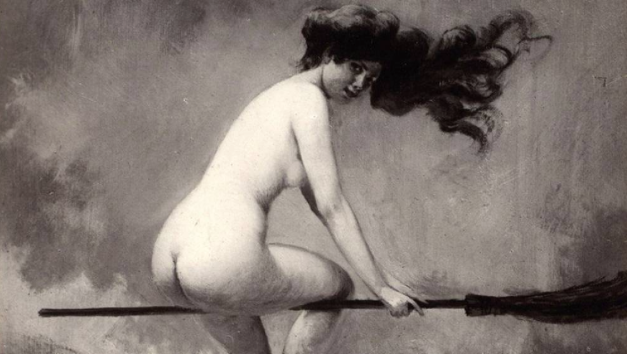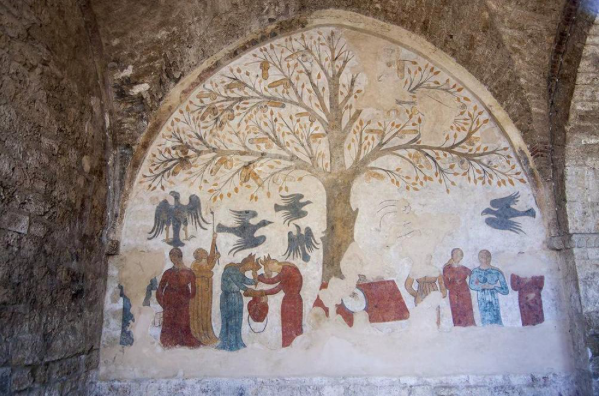 Callie Beusman. Les sorcières du Moyen Âge voleuses de pénis. Article paru dans la revue « Broadly », en 2016, et traduit par la revue « Vice ». 2016.
Callie Beusman. Les sorcières du Moyen Âge voleuses de pénis. Article paru dans la revue « Broadly », en 2016, et traduit par la revue « Vice ». 2016.
Nous reproduisons ici d’abord la traduction française de l’article, puis l’article original à la suite.
Depuis des temps immémoriaux, les hommes s’inquiètent de manière irrationnelle pour leur pénis. Bien avant l’angoisse de castration, il existait une crainte encore plus sinistre : le mythe des sorcières voleuses de phallus, qui gardaient des pénis coupés en guise d’animaux de compagnie.
La description la plus célèbre de cette pratique apparaît dans Le Marteau des Sorcières(Malleus Maleficarum), un manuel de chasse aux sorcières écrit au XVe siè cle par Heinrich Kramer. Pourtant considéré comme ridicule et misogyne par la plupart des historiens, ce traité a néanmoins entraîné d’innombrables meurtres de femmes accusées de sorcellerie ; dans The Salem Witch Trials Reader, Frances Hill le décrit comme étant « un des livres les plus terrifiants et odieux jamais écrits ». Le Marteau des Sorcières est rempli d’inquiétudes flagrantes envers le désir sexuel féminin – comme le remarque la folkloriste Moira Smith dans son article Penis Theft in the Malleus Maleficarum , « Bon nombre des crimes ( maleficia) attribués aux sorcières concernaient la sexualité : la copulation avec des incubes qui donnait lieu à des avortements, provoquait la stérilité et l’accouchement d’enfants mort-nés, et gênait les relations sexuelles entre mari et femme ».
Au Moyen Âge, on prêtait aux sorcières divers exploits magiques, comme la capacité de faire entièrement disparaître l’organe sexuel. Selon Smith, Le Marteau des Sorcières détaille trois études de cas spécifiques dans lesquelles des sorcières auraient privé des hommes de leur pénis. Les deux premières impliquent simplement des hommes dont les organes génitaux auraient été cachés par une illusion magique – les sorcières « peuvent subtiliser l’organe masculin », écrit Heinrich Kramer, « non pas en dépouillant le corps humain de celui-ci, en effet, mais en le dissimulant avec un certain glamour. »
Le troisième récit rapporte le phénomène des sorcières qui gardaient des pénis désincarnés comme animaux de compagnie et les nourrissaient d’avoine et autres céréales nutritives :
Les sorcières collectionnent les organes mâles en grand nombre, jusqu’à vingt ou trente à la fois, et les placent dans un nid d’oiseau ou les enferment dans une boîte où ils s’agitent comme des membres vivants et mangent du blé ou du maïs, ainsi qu’on a pu le vérifier maintes fois et qu’il est de notoriété publique.
Kramer décrit ensuite le cas d’un pauvre homme castré qui, après avoir perdu son membre, alla voir une sorcière bien connue afin qu’elle le lui répare. Elle lui conseilla de « grimper sur un certain arbre afin d’y choisir celui qu’il préférait dans un nid contenant plusieurs membres ». (Mais lorsqu’il voulut en prendre un gros, elle lui dit qu’il ne pouvait pas, car celui-ci « appartenait au curé de la paroisse ».)
Fresque représentant un arbre à phallus, découverte en Toscane. Photo via Wikipedia
En 2000, des archéologues firent une découverte pour le moins surprenante dans une petite ville de Toscane : une immense fresque du XIIIe siècle, comportant un arbre aux branches chargées d’organes sexuels masculins (« C’est un arbre à phallus ! » s’est exclamé l’un d’eux, Mattelaer), lesquels sont tous « excessivement grands et clairement turgescents ». Sous l’ arbre se tiennent huit femmes, deux d’entre elles semblent lutter contre un pénis et l’une d’elles et même armée d’un bâton et s‘apprête à taper sur un des « fruits» pour le faire tomber. Une autre femme semble être nullement impliquée – mais en y regardant de plus près, comme le remarque Mattelaer, « un des fruits de l’arbre dépasse de ses fesses ». Selon George Ferzoco, directeur du Centre d’é tudes toscanes, la fresque constitue « la première représentation artistique de femmes agissant comme des sorcières », faisant référence à un ancien folklore toscan selon lequel des sorcières gardaient des pénis en captivité dans des nids.
Dans Le Marteau des Sorcières, Kramer écrit : « Toute sorcellerie vient du désir charnel qui, chez la femme, est insatiable ». En ses purs fondements, l’arbre à pénis – et son association aux sorcières continuellement lascives – soulève une question intéressante : si les bites poussaient sur les arbres, aurait-on besoin des hommes ?
•
• •
ARTICLE ORIGINAL.
Callie Beusman. Witches Allegedly Stole Penises and Kept Them as Pets in the Middle Ages. Broadly, 2016.
According to a 15th century guide to detecting and eradicating witchcraft, witches were capable of making penises vanish—and some even kept them in nests and fed them oats.
Since time immemorial, men have worried irrationally about perceived threats to their penises. Long before there was castration anxiety, there was something far more sinister: the myth of phallus-stealing witches who kept wriggling, dismembered members as pets.
The best-known description of this practice occurs in the Malleus Maleficarum, a 15th century witch hunting manual written by Heinrich Kramer. Historians typically regard it as a ludicrous and misogynistic text that nonetheless resulted in countless vicious murders of women accused of witchcraft; in Te Salem Witch Trials Reader, Frances Hill describes it as « one of the most terrifying and obnoxious books ever written. » The Malleus is rife with obvious anxieties about female sexual desire—as folklorist Moira Smith notes in her paper, Penis Theft in the Malleus Maleficarum, « Many of the crimes (malefic) attributed to witches concerned sexuality: copulation with incubus devils, procuring abortions, causing sterility and stillbirth, and impeding sexual relations between husbands and wives. »
Read more : The Real Witches of Salem. Massachusetts. :
In the Middle Ages, witches were thought to have various magical dick-ruining capabilities, the most sinister of which is the ability to make the sex organ vanish entirely. According to Smith, the Malleus Maleficarum details three specific case studies in which witches were said to have magically deprived men of their penises. The first two simply involve men having their genitals hidden by some magical illusion—witches « can take away the male organ, » Heinrich Kramer writes, « not indeed by despoiling the human body of it, but by concealing it with some glamour. »
The third account notoriously mentions the phenomenon of witches keeping disembodied penises as pets and feeding them oats and other nutritious grains:
[W]hat shall we think about those witches who somehow take members in large numbers—twenty or thirty—and shut them up together in a birds’ nest or some box, where they move about like living members, eating oats or other feed? This has been seen by many and is a matter of common talk. It is said that it is all done by devil’s work and illusion, for the senses of those who see [the penises] are deluded in the way we have said.
[W]hat shall we think about those witches who somehow take members in large numbers—twenty or thirty—and shut them up together in a birds’ nest or some box, where they move about like living members, eating oats or other feed? This has been seen by many and is a matter of common talk. It is said that it is all done by devil’s work and illusion, for the senses of those who see [the penises] are deluded in the way we have said.
Kramer goes on to describe one man’s quest to restore his missing member. By his account, the poor, castrated fellow « approached a certain witch » who instructed him to « climb a particular tree where there was a nest containing many members, and allowed to take any one he liked. » (He was unfortunately rebuffed after trying to pick a particularly large one because « it belonged to a parish priest. »)
Gonad-bearing flora were not uncommon in the Middle Ages. In a 2010 article published in the Journal of Sexual Medicine, historian Johan J. Mattelaer states, « Between the end of the 13th century and the early 16th century, the phallus tree was quite a phenomenon. » Penis trees flourished throughout Europe, according to his research: A 14th century French manuscript contains two images of nuns harvesting penises from trees and tucking them into their robes; a wood carving from the early 15th century currently kept at a museum in Germany depicts a woman casually plucking penises while her lover peruses a vulva tree; and a decorative badge found in the Netherlands « shows a couple making love under a phallus tree, possibly being watched by a voyeur. »
A phallus tree mural uncovered in Tuscany. Photo via Wikipedia.
In 2000, archaeologists uncovered a particularly impressive penis tree specimen: a massive mural from the 13th century, located in Tuscany. It depicts a tree covered in male sex organs (« It is indeed a phallus tree! » Mattelaer notes jovially), all of which were « disproportionately large and… clearly in an aroused state. » By the noble plant’s roots stand eight women, two of whom appear to be fighting over a penis and one of whom is trying to knock one off a branch using a stick. Beside them is another woman who appears to be mostly uninvolved—but who, upon closer inspection, as Mattelaer notes, « has one of the fruits of the tree protruding from her bottom. » George Ferzoco, the director of the Center for Tuscan studies, has argued that the mural constitutes « the earliest depiction in art of women acting as witches, » citing ancient Tuscan folklore about witches keeping penises captive in nests.
For more Stories Like This, Sign Up for Our Newsletter.
In the Malleus Maleficarum, Kramer writes, « All witchcraft comes from carnal lust, which in women is insatiable. » In its purest essence, the penis tree—and its association with endlessly lascivious witches—raises a compelling question: If dick grew on trees, would anyone need men?



[…] Les sorcières du Moyen Âge voleuses de pénis […]